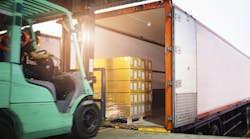The three buckets of freight for trucking—household consumption/consumer spending, residential and highway-related construction, and the industrial side of the economy—are all solid, according to American Trucking Associations’ Chief Economist Bob Costello.
During a Nov. 30 U.S. Bank webinar, Costello said he expects freight will remain “robust” in 2022, with inventory-to-sales ratios at an all-time low.
“That’s why you see a lot of retailers try to get in as much product as possible,” he said. “People still have high expectations as to how fast stuff is going to get to their doorstep. So even if sales slow a bit early next year, retailers will have to bring in a lot of freight to get us back to where we were prior to the pandemic.”
See also: Index sees truck driver availability ‘improving considerably’
Those healthy freight expectations, however, are in an environment where the labor force participation rate remains “stubbornly low,” Costello pointed out. There are more than 10 million job openings and a labor participation rate below 62%.
Another major concern today is inflation. In October, the Consumer Price Index (CPI) was at 6.2% year-over-year. That, according to the Bureau of Labor Statistics, is the largest 12-month increase since November 1990.
“It’s going to get worse,” Costello advised, saying he expects more than 7% year-over-year increases for the CPI. “The Federal Reserve will continue to accelerate their reductions and purchases enough that by March, quantitative easing will be over. And once that is over it opens the door for interest rate hikes.
“They don't set interest rates for today,” he added. “They are setting interest rates today for 12-18 months down the road. There is a lot of debate on whether they will need to do this sooner rather than later.”
By the end of next year, however, Costello said he expects inflation will decrease to 3% year-over-year, rather than staying at the higher 6% to 7%.
“The three buckets of freight are good, but inflation is going to get worse than it is right now,” Costello advised. “The pandemic is something we are going to have to live with. It’s something we are going to get used to, but it can still punch us in the gut.”
Trucking demand and the driver shortage
In a normal environment, the truckload market is dominated by the contract market. Today’s supply problems, however, have caused more movement through the spot market.
This summer, shippers unable to move all their freight with their contract carriers pivoted more to the spot market, Costello noted. In the dry van space, dedicated loads are up 3% this year. Yet, the one-way truckload, down -5.5% year to date, is off significantly. On the LTL side, tonnage trends are up almost 8% year to date compared to -1.1% in 2020.
“During the pandemic, we started buying things that we would have never thought about buying online prior to the pandemic including bigger ticket items,” Costello said, adding that LTL is benefitting from overflow freight from the spot market. “It's also benefiting from the truckload sector. Not only are shipping having to go to the spot market, but they're also turning to LTL fleets, to get some of that moved and LTL carriers are doing a better job with [retaining] drivers.”
ATA recently reported a driver shortage at just over 80,000—80,123 to be exact—for this year. Costello reiterated that if trends don’t change by 2030, the industry will be short more than 150,000 drivers.
As of October, 75,000 drivers are in prohibited status in the federal Drug & Alcohol Clearinghouse. More than 55,000 of those drivers have yet to begin the return-to-duty process. Some drivers also have left the industry or retired early because of the pandemic.
“Now, you don't need an economist here to tell you when you have a situation where you have demand outstripping supply and what happens to price? It goes up,” Costello advised. “It is no different in the truck driver market.
“Driver pay is going up even more than earnings, and we know that when some drivers get paid more, they will choose to drive less, make the same money and be home more often,” he continued. “So, I think I rates are going up even more.”
Costello added that more drivers are leaving linehaul to take more local routes as more of those last-mile jobs become available due to surges in ecommerce.
“This tells me it’s about lifestyle,” he said. “People want to be home more often. I hear this from drivers, and I hear this from fleets, but the data backs it up. Drivers want to be home more often, and if they can get a local job then they will take it.”
As to how vaccine mandates play a role for cross-border truckers and may further impact the driver shortage? Right now, drivers are deemed essential and do not have to show proof of vaccination to go into Canada or Mexico. Come mid-January, all drivers will have to show proof of vaccination while entering Canada, Costello pointed out.
“You should prepare for mid-January that all drivers will have to show proof of vaccination going into Canada and coming into the U.S.,” he said. "This is a real concern. Stay tuned on that. We will have more to come.”




